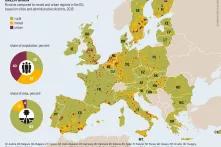

Natura 2000 is the system of protected areas set up by the EU in response to two European Commission Directives for nature conservation: the Habitats Directive of 1992, and the Birds Directive amended in 2009. The Natura 2000 Network in Italy consists of 612 spaces designated as Special Protection Areas for birds, and 2,332 Sites of Community Importance of which 1,733 are Special Areas of Conservation to protect habitats and non-bird species. In an estimated 335 sites these areas overlap and are classified as both. Taken as a whole, the Network covers 6,414,548 hectares – 5,826,777 hectares of land and 587,771 of sea. That accounts for 19.29 percent of Italy’s land surface and 3.81 percent of its marine area.
Historically, agriculture has played a fundamental role in determining the structure and composition of the ecosystems covered by the Natura 2000 sites. At the same time, agriculture is today one of the main threats to the conservation of biodiversity and a major cause of the destruction and simplification of habitats, as well as the contamination of water, soil and air resulting from the intensive use of pesticides and chemical fertilizers.
Recent research by the World Wide Fund for Nature and CREA (an Italian research agency) on behalf of the National Rural Network has revealed the number of farms covered by the Natura 2000 sites. This included farms that had at least one parcel of agricultural land within the Natura 2000 boundaries. That amounts to a total of 214,535 farms that are associated with the Natura 2000 network.
These farms encompass over 2.7 million hectares of agricultural land within the Natura 2000 sites, equal to 16 percent of Italy’s agricultural area. Of those, 1.5 million hectares were actually used for agriculture, or 13 percent of the country’s utilized agricultural area. About one-quarter (24.7 percent) of these farms were small, using less than one hectare for farming. Another 23 percent were between 1 and 3 hectares, 10 percent were between 3 and 5 hectares, and almost 19 percent were between 5 and 15 hectares. A mere 14.2 percent were larger holdings over 30 hectares.
Some 37.6 percent of all farms associated with Natura 2000 had less than 30 percent of their utilized area within a protected area. At the other end of the scale, 23 percent of these farms had 80 percent of their land under protection, and 15.2 percent were entirely within a protected area.
For the farmland covered by Natura 2000 sites, the main land uses were woodland (32 percent), followed by rough grazing (24 percent) and arable (20 percent). Minor uses included permanent grassland i.e.,fodder areas that cannot be cultivated (9 percent), followed by non-cultivated areas (7 percent), and tree crops including olives, vines and orchards (5 percent). Water bodies took up the remaining 2 percent. Woodland was the main land use in all three of Italy’s biogeographical regions: alpine, continental and Mediterranean. This was followed by rough grazing in the alpine and Mediterranean regions, and arable land in the continental areas. The Mediterranean region has the largest absolute extent of permanent grassland.
The agricultural area within the Natura 2000 sites that has not been included in any register to benefit from Common Agricultural Policy support is also of interest. This “ghost” agricultural land covers those areas where requests for support under either Pillar I or II, have not been made but which might be eligible for funding. It covers 18.1 percent of the Natura 2000 area. In some regions, the undeclared agricultural area falling into a Natura site is larger than the area that does qualify for CAP payments. This is the case in Campania, Liguria, Sardinia and Tuscany.
The 21 rural development programmes managed by the regions and the autonomous provinces of Trento and Bolzano include 11 “Measures” and 228 “sub-Measures” or “Operations”, each focussing on a specific aspect. These are linked directly to the protection and enhancement of biodiversity and to the management of Natura 2000 sites and other protected natural areas. Direct Operations enable interventions that contribute to the conservation of habitats and species, and to the management of areas of high natural value. These benefit farms as well as public or private entities that manage Natura 2000 sites and other protected areas – 144 Operations or sub-Measures in all.


